Last February, the Umbra Institute signed an agreement with Fuori di Zucca, (whose literal translation in English is “Out of Pumpkin” but whose meaning in Italian is “crazy”), a volunteering association that manages a Solidarity Purchasing Group. Their aim is creating a small community that would buy fresh food (i.e., vegetables, fruit, cheese, etc.) in a conscious and alternative way.The purchase of local produces takes place according to the principle of solidarity, which leads them to prefer small and local producers, respectful of the environment and people, with whom they have established a direct and stable relationship.
Thanks to the agreement, Umbra students can take part to the activities of this association and immerse themselves in a lively community of local food producers and consumers. Spring semester students have seized this opportunity and are volunteering in the weekly shopping and food distribution which is held every Wednesday. Students became active members of the Association, and they were provided with a membership card, with which they can buy local food.
In addition to sustaining local farmers, Fuori di Zucca has also launched an initiative through which the complete weekly shopping (vegetables, eggs, bread, pasta, cheeses, legumes) is guaranteed to five families in need of support residing in the neighborhood where Fuori di Zucca meets. This initiative is supported by the members of the association (with small donations), from producers (who charge half price for the products of the shopping for these families), and from others fundraising activities.
The Umbra Institute is happy to be part of this meaningful project and is looking forward to strengthen its ties with Fuori di Zucca “Crazy” association!


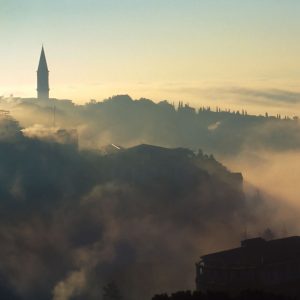
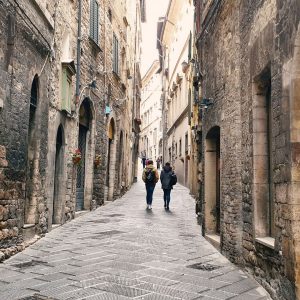
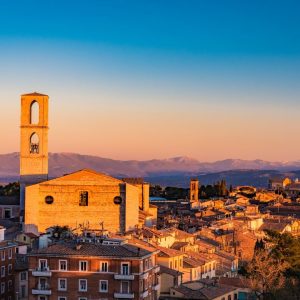
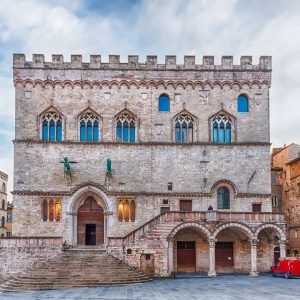
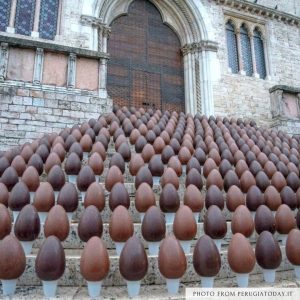
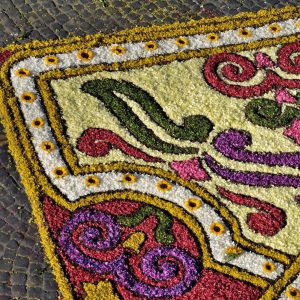
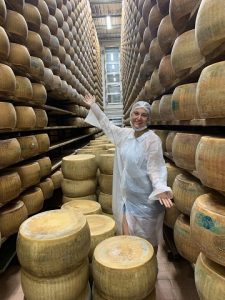 One of my best weekends abroad was when the FSE visited Parma and Modena to tour the Parmigiano Reggiano cheese, Modena Balsamic Vinegar, and Prosciutto di Parma production facilities. Having local food producers walk us through the process of creating these traditional products was an incredible experience, one that I probably would not have gotten if I had studied abroad in a different country. For example, the appellation and DOP/DOCG region system is something that sets Italy apart from the US and other countries for food and wine production. Certifying products from these areas ensures top quality and preserves Italian food culture, but being limited to the specific region boundaries makes it harder for producers and farmers to adapt to changing climate conditions. For example, within the last few decades, the Parmigiano Reggiano cheese producers have had to use air conditioning in their facilities to maintain the correct cheese temperature and they changed the cow breed they use to make the milk. The cheese-making facility also has stainless steel machinery and copper cauldrons for a sanitary production process. This is where the blend of traditional artisanal production techniques and modern technology is critical to maintaining sustainability, of both the business and the local cuisine. And it was a unique experience for me to explore these sustainable examples of food production that exemplify a middle ground between small family farms and massive industrial facilities. This is something that is hard to imagine and get the opportunity to see in the United States.
One of my best weekends abroad was when the FSE visited Parma and Modena to tour the Parmigiano Reggiano cheese, Modena Balsamic Vinegar, and Prosciutto di Parma production facilities. Having local food producers walk us through the process of creating these traditional products was an incredible experience, one that I probably would not have gotten if I had studied abroad in a different country. For example, the appellation and DOP/DOCG region system is something that sets Italy apart from the US and other countries for food and wine production. Certifying products from these areas ensures top quality and preserves Italian food culture, but being limited to the specific region boundaries makes it harder for producers and farmers to adapt to changing climate conditions. For example, within the last few decades, the Parmigiano Reggiano cheese producers have had to use air conditioning in their facilities to maintain the correct cheese temperature and they changed the cow breed they use to make the milk. The cheese-making facility also has stainless steel machinery and copper cauldrons for a sanitary production process. This is where the blend of traditional artisanal production techniques and modern technology is critical to maintaining sustainability, of both the business and the local cuisine. And it was a unique experience for me to explore these sustainable examples of food production that exemplify a middle ground between small family farms and massive industrial facilities. This is something that is hard to imagine and get the opportunity to see in the United States. 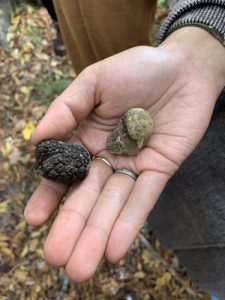 Not only did we participate in facility and farm tours and educational presentations, but we also got to sample the delicious dishes at each of the trip locations! Some of the best meals I’ve had in Italy and in my lifetime have been on the FSE field trips, including gnocchi with truffle oil during the truffle hunting field trip and 25-year aged balsamic vinegar on vanilla gelato in Modena.
Not only did we participate in facility and farm tours and educational presentations, but we also got to sample the delicious dishes at each of the trip locations! Some of the best meals I’ve had in Italy and in my lifetime have been on the FSE field trips, including gnocchi with truffle oil during the truffle hunting field trip and 25-year aged balsamic vinegar on vanilla gelato in Modena. 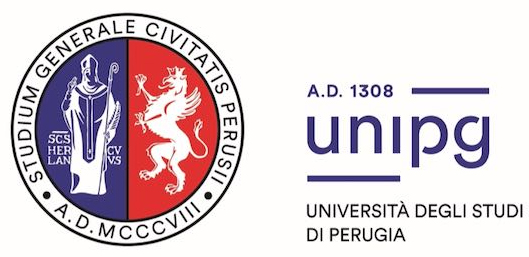 The Umbra Institute’s didactic garden,
The Umbra Institute’s didactic garden, 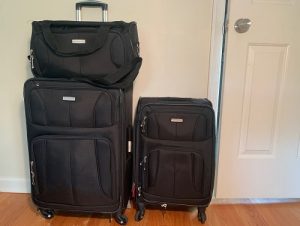 When packing for your study abroad experience, there are four important items that you should make sure you have packed.
When packing for your study abroad experience, there are four important items that you should make sure you have packed.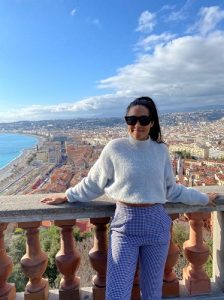 Now it is time to share what most people probably came to this article; to figure out what types of clothing to bring with you for your four-month abroad experience in Italy. Before giving you my recommendations on what types of clothes you should bring, I think it is important to note some important aspects of packing. First off, do not pack outfits. You will be in Italy between 110-120 days unless you decide to stay longer. Your suitcase will not be able to fit 122 different outfits. Therefore, I recommend bringing clothing items that can be interchanged with one another. In addition to this, remember that you are going to Italy, which is one of the biggest fashion capitals in the world. So, don’t be afraid to take a break from your sweatpants and try new clothes that you may have been too scared to wear here in the United States. I encourage you to take advantage of your creativity and to get out of your comfort zone with your fashion pieces!
Now it is time to share what most people probably came to this article; to figure out what types of clothing to bring with you for your four-month abroad experience in Italy. Before giving you my recommendations on what types of clothes you should bring, I think it is important to note some important aspects of packing. First off, do not pack outfits. You will be in Italy between 110-120 days unless you decide to stay longer. Your suitcase will not be able to fit 122 different outfits. Therefore, I recommend bringing clothing items that can be interchanged with one another. In addition to this, remember that you are going to Italy, which is one of the biggest fashion capitals in the world. So, don’t be afraid to take a break from your sweatpants and try new clothes that you may have been too scared to wear here in the United States. I encourage you to take advantage of your creativity and to get out of your comfort zone with your fashion pieces!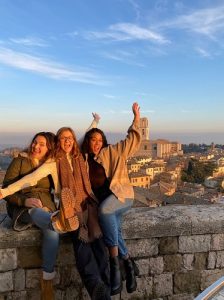 But the most important items are…
But the most important items are…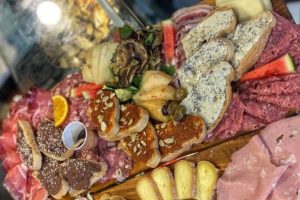 Charcuterie: La Prosciutteria
Charcuterie: La Prosciutteria 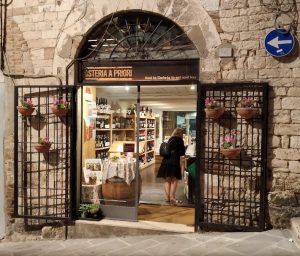 Traditional Osteria: Osteria a Priori
Traditional Osteria: Osteria a Priori 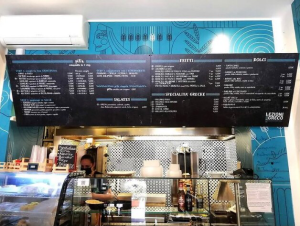 Non-Italian: Lezioni Di Greco Corner
Non-Italian: Lezioni Di Greco Corner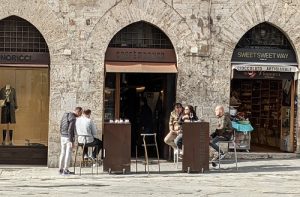 Caffè del Banco
Caffè del Banco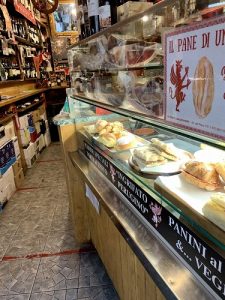 Caffè Dal Perugino
Caffè Dal Perugino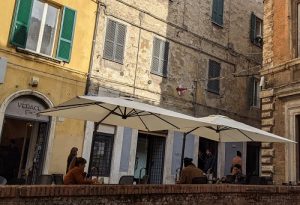 Verace
Verace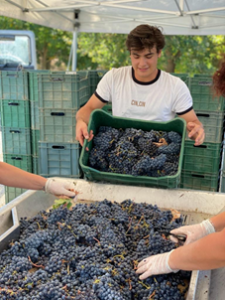 Grape Harvest and
Grape Harvest and 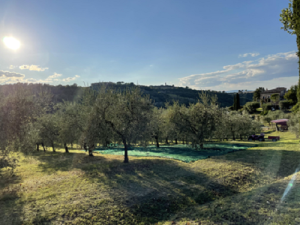 Olive Harvest
Olive Harvest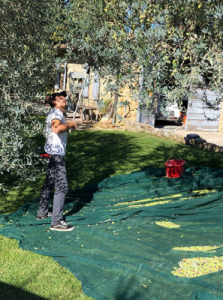 The process for collecting the olives involves laying down large mesh tarps under an area of trees to collect the olives as they fall. A few workers were equipped with a long pole with motorized “fingers”, for lack of a better word, situated at the end which shook the branches of the tree causing the olives to fall down. The majority of us, however, used long rakes which comb over the branches, pulling off only the olives. My day consisted of traveling from area to area laying down the tarps, raking the trees clean of olives and loading them into crates to be picked up. We picked 3 classic types of Italian olives: Leccino, Moraiolo, and Frantoio; the blending of which creates the best extra-virgin olive oil I have tasted and certainly unlike anything I have ever tried. The color of which is a hazy-green and tastes as though it is filled with spices. By the time we finished working, I realized that I had learned a lot of the terminology that was used during the day, the Italian words for tarp, stake, box and rake to name a few. My evening concluded with two kinds of homemade cake that Eileen made and brought into the olive grove for all the workers. There we engaged in chit chat and watched the beautiful sunset below the Umbrian hills. I exchanged contact information with some of the workers with whom I plan to see again.
The process for collecting the olives involves laying down large mesh tarps under an area of trees to collect the olives as they fall. A few workers were equipped with a long pole with motorized “fingers”, for lack of a better word, situated at the end which shook the branches of the tree causing the olives to fall down. The majority of us, however, used long rakes which comb over the branches, pulling off only the olives. My day consisted of traveling from area to area laying down the tarps, raking the trees clean of olives and loading them into crates to be picked up. We picked 3 classic types of Italian olives: Leccino, Moraiolo, and Frantoio; the blending of which creates the best extra-virgin olive oil I have tasted and certainly unlike anything I have ever tried. The color of which is a hazy-green and tastes as though it is filled with spices. By the time we finished working, I realized that I had learned a lot of the terminology that was used during the day, the Italian words for tarp, stake, box and rake to name a few. My evening concluded with two kinds of homemade cake that Eileen made and brought into the olive grove for all the workers. There we engaged in chit chat and watched the beautiful sunset below the Umbrian hills. I exchanged contact information with some of the workers with whom I plan to see again.